Science Friday’s Second Life: The Voyage Home
27:23 minutes
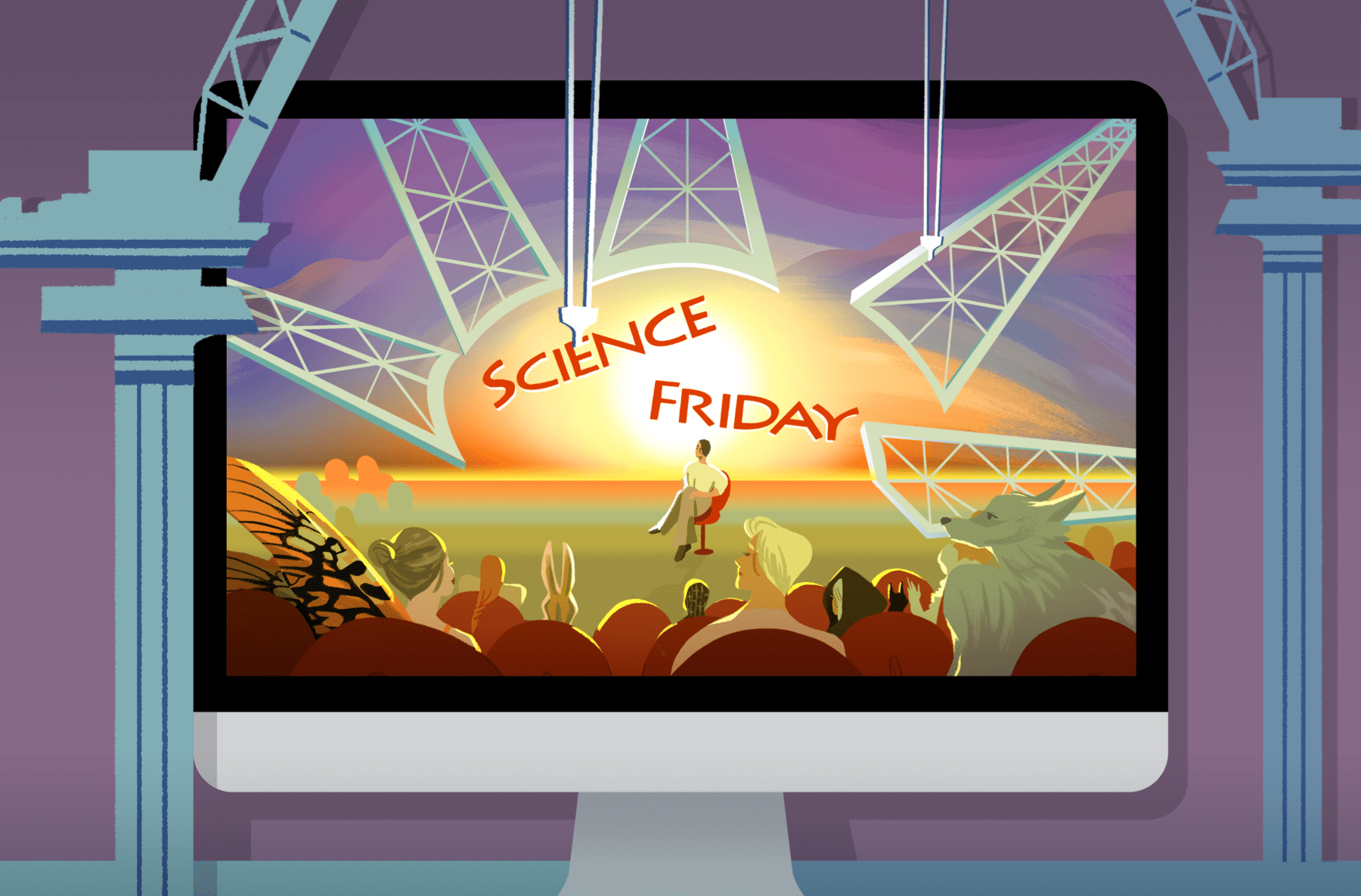
 Do you remember Second Life? That online virtual world where you can create an avatar, build whatever you want, and meet people? It was a hit in the late 2000s, quickly becoming a pop culture phenomenon—and it had over a million users at its peak. Second Life was so big that Science Friday created a community there in 2007. We livestreamed our show in-world every Friday, and a huge community of avatars—humans, fairies, wolves, dogs with wings—would gather with us every week to listen.
Do you remember Second Life? That online virtual world where you can create an avatar, build whatever you want, and meet people? It was a hit in the late 2000s, quickly becoming a pop culture phenomenon—and it had over a million users at its peak. Second Life was so big that Science Friday created a community there in 2007. We livestreamed our show in-world every Friday, and a huge community of avatars—humans, fairies, wolves, dogs with wings—would gather with us every week to listen.
Sadly, after a couple years, our staff left Second Life, and the space was dismantled. But we recently learned that for the last ten years, some members of that original community have still been meeting up virtually to listen to the show every week.
Producer D Peterschmidt catches up with the group to find out what they had to do to survive in the virtual landscape, what the online community is like today, and what they’ve learned while spending over a decade in Second Life.
We’ll also hear from Celia Pearce, an associate professor of game design at Northeastern University, and Katherine Isbister, a human computer interaction and games researcher at the the University of California, Santa Cruz, about how virtual worlds like Second Life can help us cope with the quarantine-induced reality we live in now.
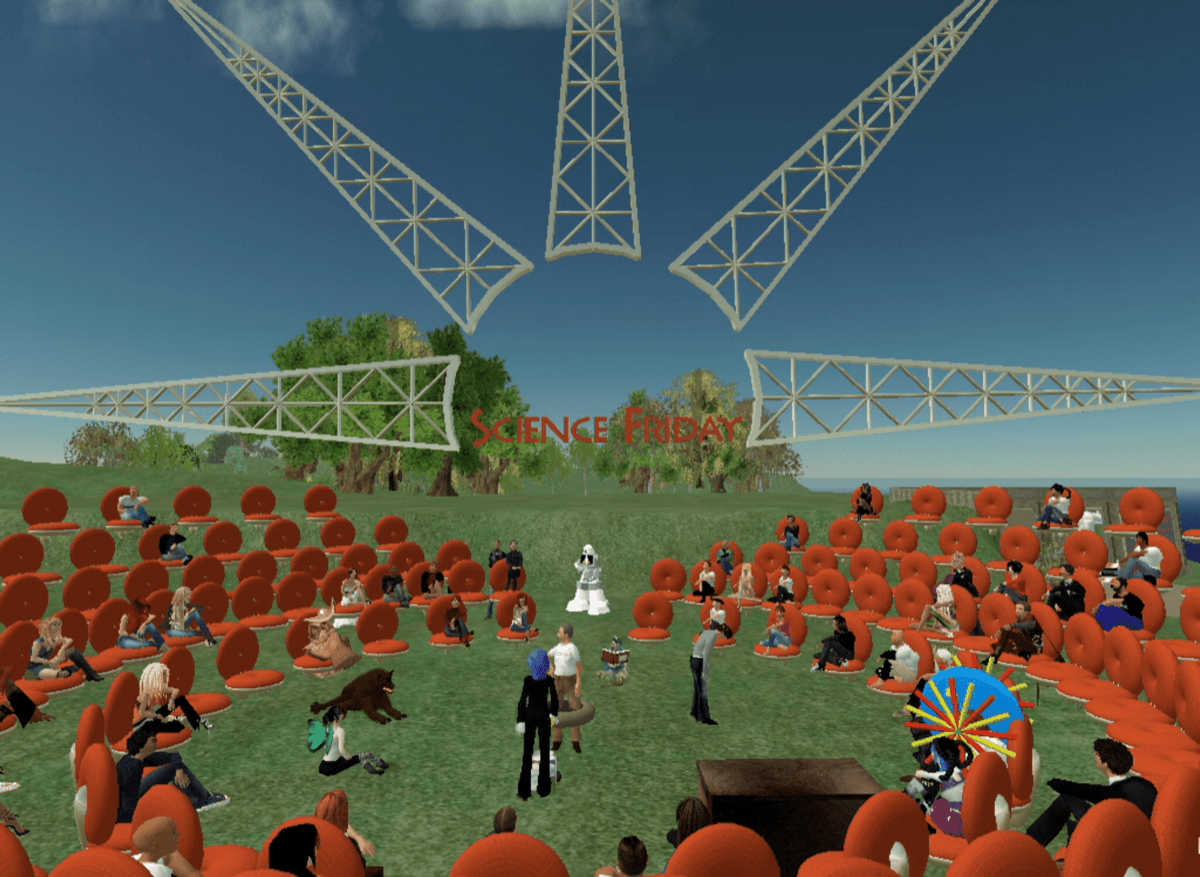
Unlimited creativity and freedom of expression draws users to virtual worlds like Second Life. Linden Labs, the developer of Second Life, provides little pre-made content—just a few lands for new users to get their bearings, explains Matt Burr, one of the original SciFri Second Life members. But once you venture beyond those virtual terrains, you’ll discover digital wonders, all completely designed by Second Life users.
“There’s just a huge amount of creativity being expressed, not just in the various environments you can explore, but also in the way people create their avatars,” says Burr. “There’s virtually an infinite variety of choices you can use to create the look of your avatar. All of that makes Second Life a pretty unique virtual world.”
Meet and learn more about some of the OG Science Friday Second Life crew, including how they designed their avatars and why they like to explore virtual worlds. (We’ve edited their responses for length and clarity.)
Matt Burr, original and current SciFri Second Life member
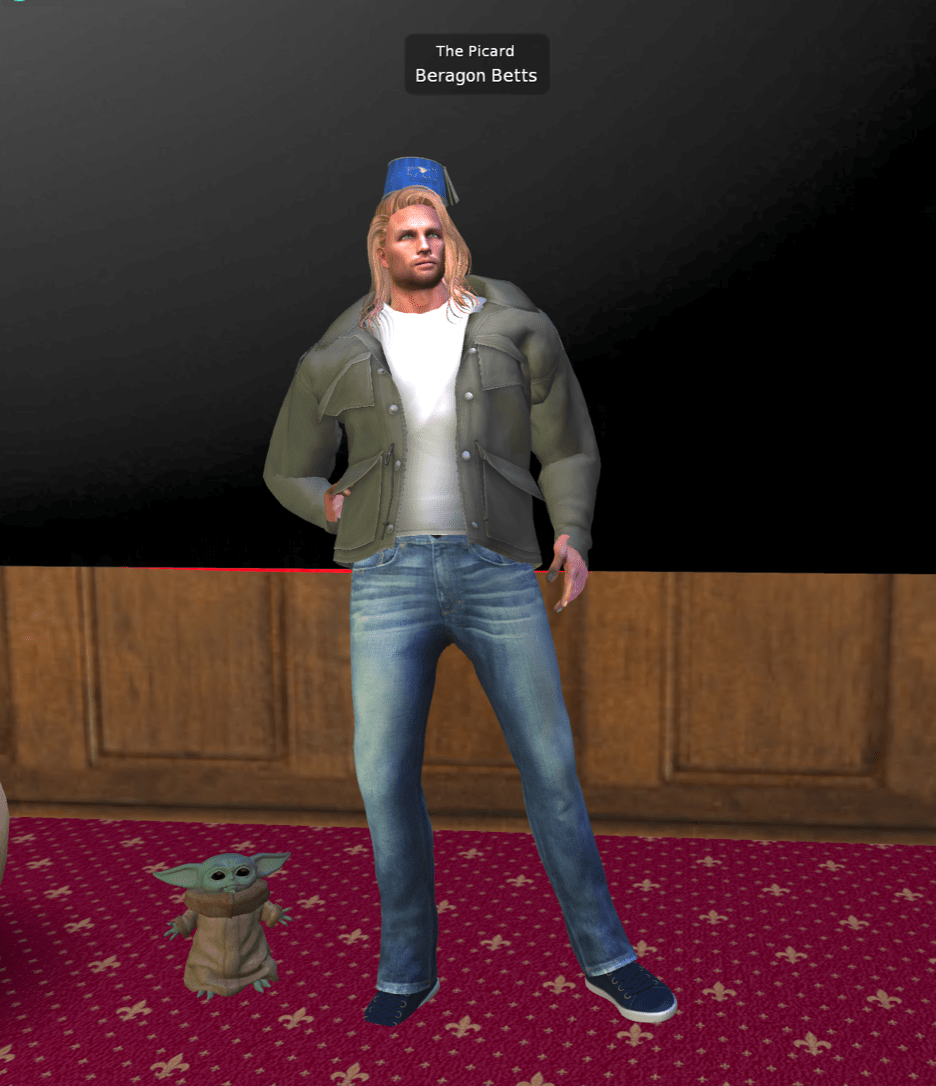
My avatar’s name is Beragon Betts. It’s the same as my Twitter handle! That’s an online persona I’ve had since the mid-90s when I was in CompuServe. The name Beragon actually comes from Mystery Science Theater 3000, from Great Monster Duel: Gamera vs. Barugon, the [1966] Japanese monster movie. I kind of changed the spelling to make it more cool, but that’s where I got the basic idea for the name.
And my avatar is really handsome. One of the realities of Second Life is that it has a lot of adult content, which I enjoy. For that reason, I select my avatar to be hot. My avatar has gone through a fantastic evolution over the last 11 years—just completely transformed himself. Obsessing over your avatar is a major pastime in Second Life. So people are constantly tweaking their avatars.
Original and current SciFri Second Life member
I’m pretty stuck down on a sort of idealized version of myself. But I do still like to play around with different looks. One of my favorite avatars is like a realistic rabbit. I have tons of rabbit avatars. As for why, I don’t know, bunnies always spoke to me. I’ve had them before.
I sort of imagined that [virtual worlds] would become more common—as it became more accessible, that you’d see more of these platforms and programs moving into virtual spaces like this. That was kind of the trend at the time. I remember a lot of institutions wanted a presence in Second Life. That’s not exactly worked out the way I envisioned it then, but at the time, it felt like this was sort of the wave of the future.
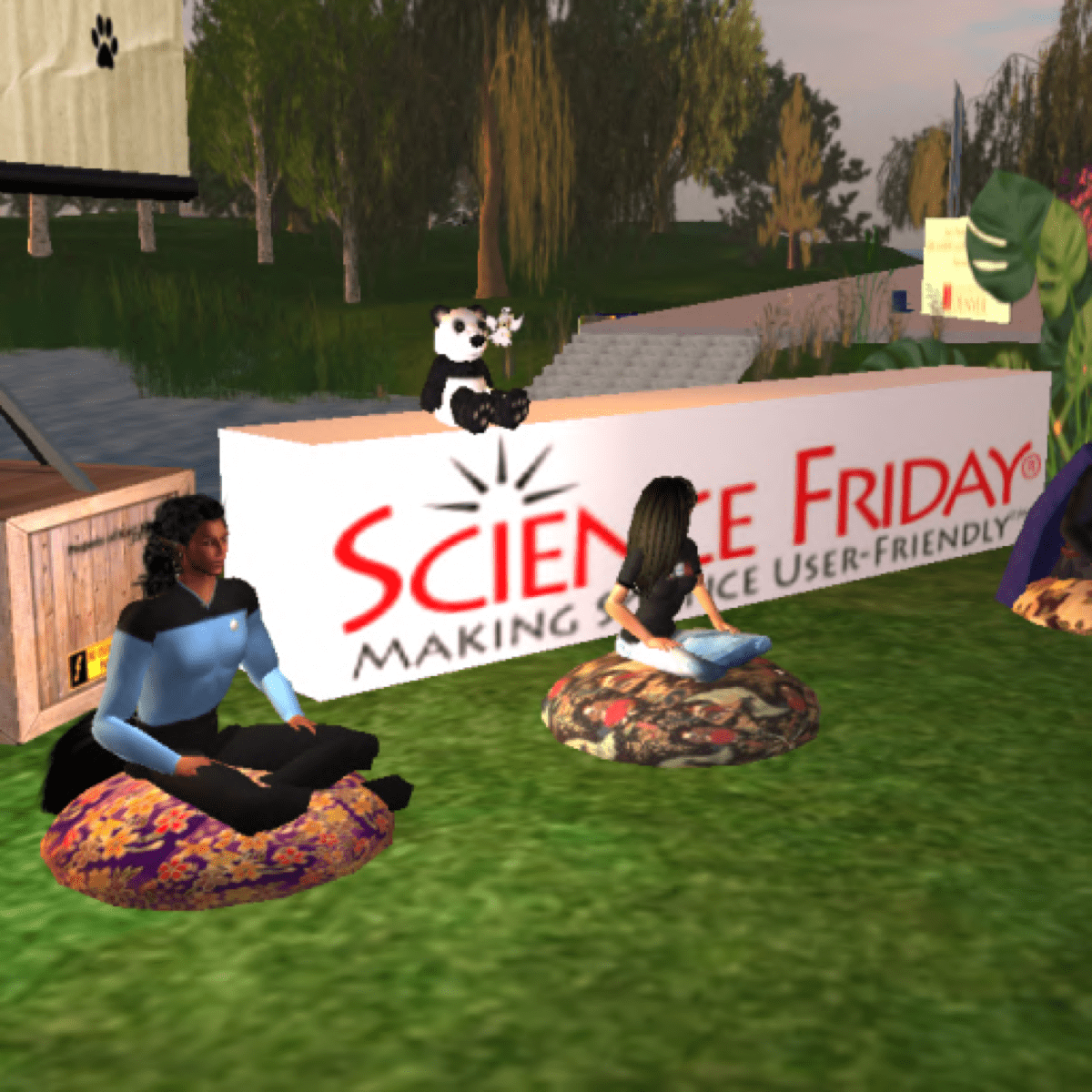
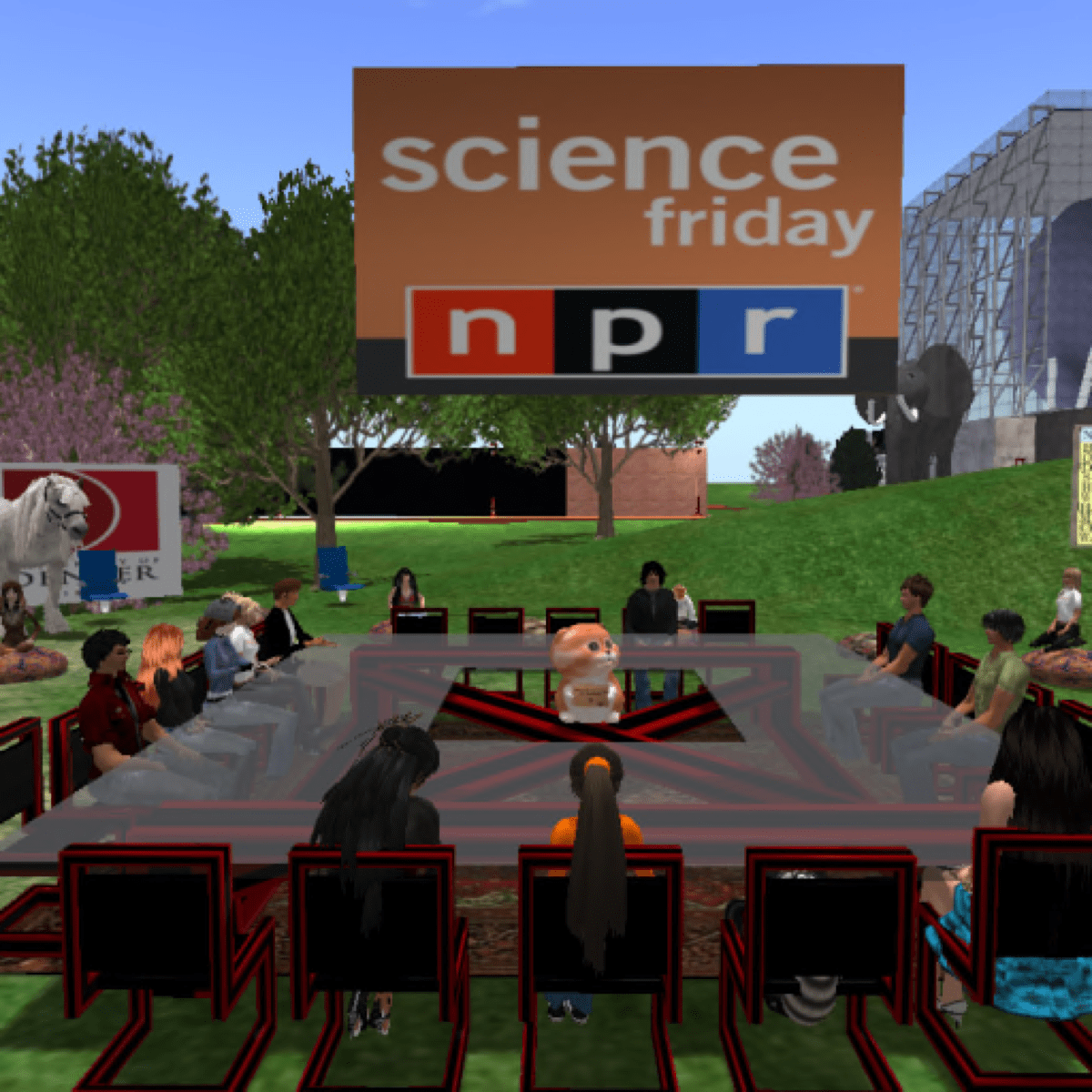
It’s kind of a familiar and comforting space, especially in recent times. To have a space that’s familiar, that has people you know, and something you do as kind of a routine thing—I appreciate that. Just being able to access something like that and have a presence there is comforting right now. It’s like a home.
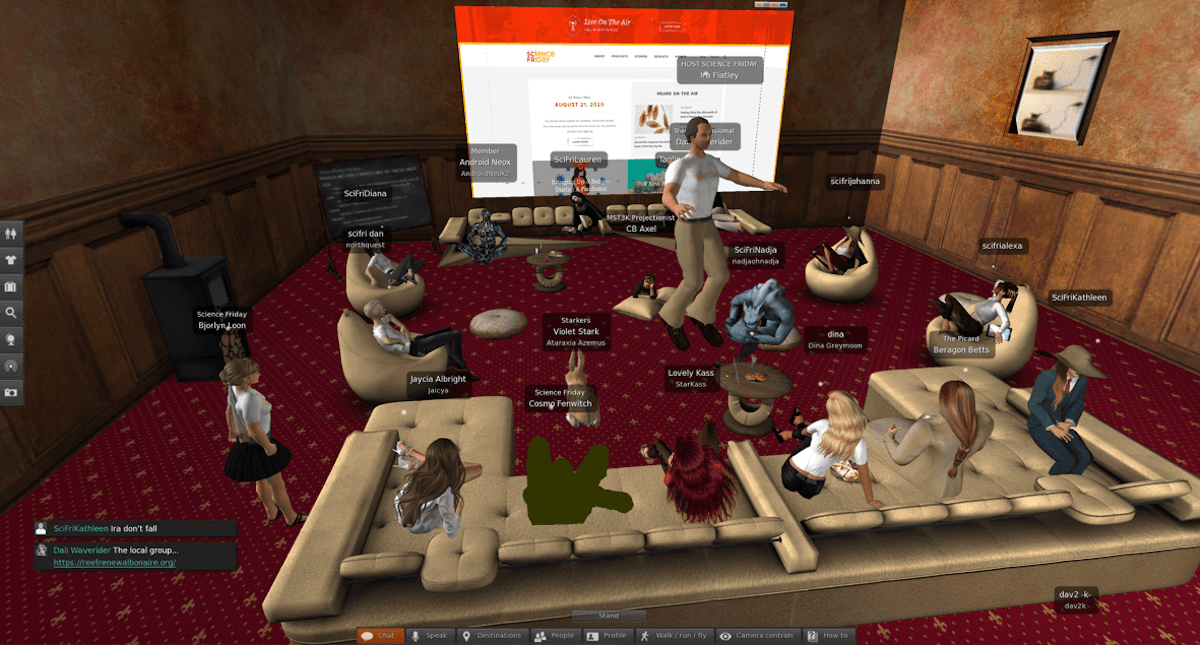
Original and current SciFri Second Life member
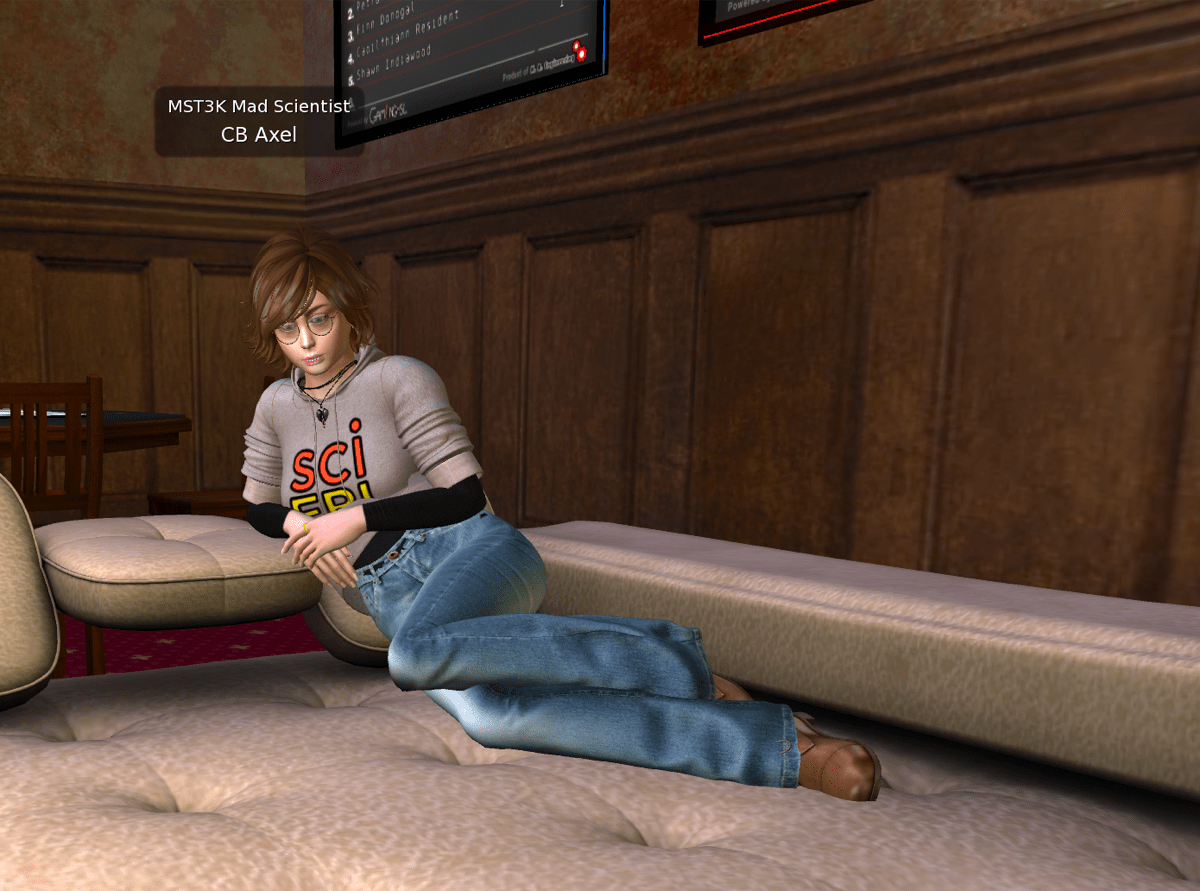
I’m CB Axel in Second Life. When I was in high school, there was this boy who for some reason thought my name was Connie Boyle. It isn’t. It’s not even that close. But he started calling me CB, so that was kind of a nickname for myself. Second Life, at that time [mid-aughts], would give you a list of surnames to choose from. I didn’t even scroll down through all of the ones they had and Axel was at the top of the alphabet.
I remember I was in a hurry to try and get online for the first Science Friday show on Second Life. If you do decide to whip up an avatar and join a group, I do not recommend waiting until 15 minutes before the show starts. My first emotion was panic because I wanted to get to the show, but there was just no way to learn everything I needed to know to do that. I listened on the radio while I was learning how to walk, run, jump, fly, teleport, sit on things and stand up again, pick things up. I’m not a gamer, so all of this stuff was completely foreign to me.
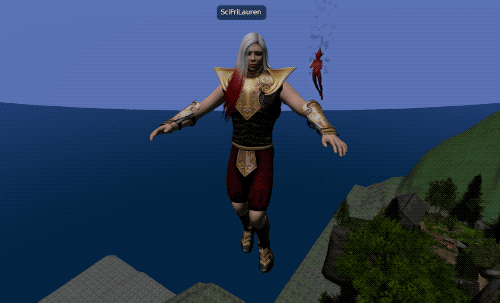
Back then when you first started, you could choose an avatar from ones by Linden Lab and mine was just a female avatar. I can’t remember real details of her, except that she is not exceptionally tall. She’s younger than I am in real life. She’s thinner than I am in real life. And it wasn’t until I hung around in Second Life a little bit that I even changed clothes. The original avatars were pretty dorky. The choices of avatars now are much better.
Lynn Cullens, original SciFri Second Life member and organizer
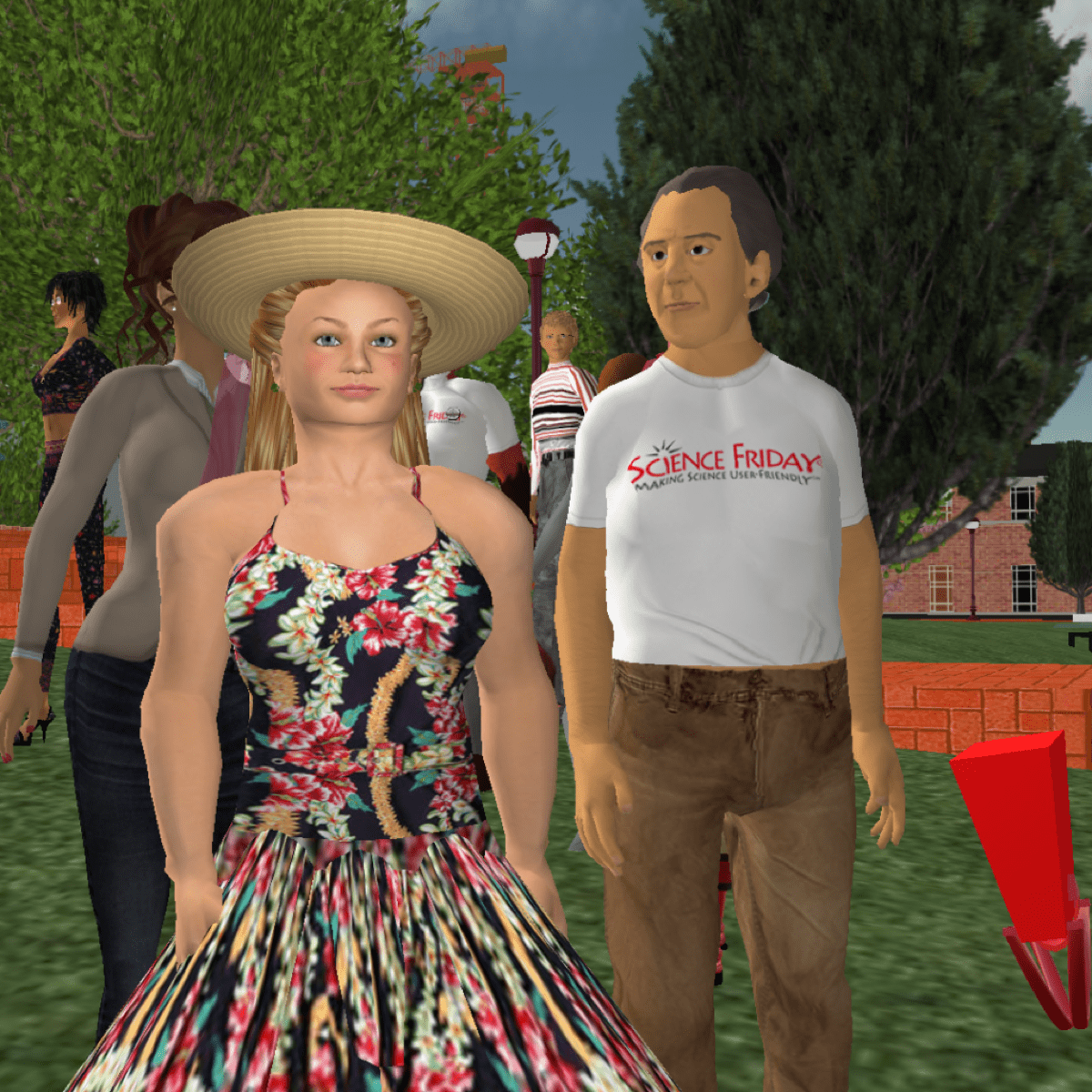
One of the last names you could choose was Loon, like the bird. I thought the whole idea of being in a virtual world was kind of loony, so I chose that as my last name. For my first name, I used Bjorlyn, a name that had been actually randomly generated for me in another game that I had been playing at the time, Dark Age of Camelot. So I was Bjorlyn Loon and I was a much younger me with shorter hair. And I loved going shopping and wearing clothes that I would not at that time have worn in my real life. I loved wearing combat boots and short skirts and crazy hairdos. But after a period of time, I actually began to look more and more like my avatar. Being able to try on different personas for pennies [some clothing items cost money] was one of the most fun aspects of creating an avatar.
Science Friday Second Life was a great experience. There was a symbiosis between Science Friday and Second Life—it was sort of magical. Science Friday brought additional legitimacy to Second Life as one of the first broadcast media to engage virtually. Science Friday helped avatars like myself find like-minded science fans in that virtual world—and that was hard to do, finding like-minded folks. But Second Life also gave Science Friday a way for fans to communicate during the show, and a little bit of a visual component for those who enjoyed being there. There was a fascinating running narrative in the chat box, and there were often experts in the chat and they could provide context to what was being discussed during the show. There was a lot of community excitement that at the time didn’t exist outside of the virtual world.
Ira Flatow, host of Science Friday and original SciFri Second Life host
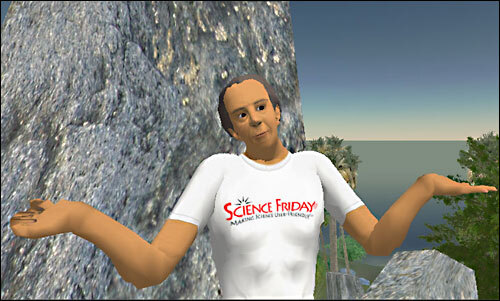
I had a lot of trouble with the Ira Flatley avatar because I could not get it to look like me. I’m not great at graphics. I can’t play hangman because I can’t draw a stick figure, so I thought I’ll do the best I can. It really was the closest thing I could make to myself. Now, I never had such a good body as that avatar has. So I was happy that at least that was available. We had a Science Friday logo so I took the logo, and I put it on a white t-shirt. I just had plain pants, and made a face as close as I could to my actual face as possible. I was really such a nerdy looking guy, because if you go into Second Life, you’ll see all the fantastic costumes.
But the name bothers me the most. It still bothers me today that it’s Ira Flatley. I’ve been called a lot of last names in my life, but never Flatley. At the time, you could run through a list of names like you can when you sign up for an email account. I chose it because that was the only thing available. I would have gone with my own name if I could. I did go looking for the other Flatow when I got into Second Life, but the system was so complex at the beginning.
I really wanted to explore the medium. The idea that you could create a whole new world, buy real estate in that world, put down roots, and have a spot where people could come and listen to Science Friday—that was crazy. Not only that, you get to have an avatar and you get to meet all these people. You might never know who these people really are. That was foretelling of the internet to come.
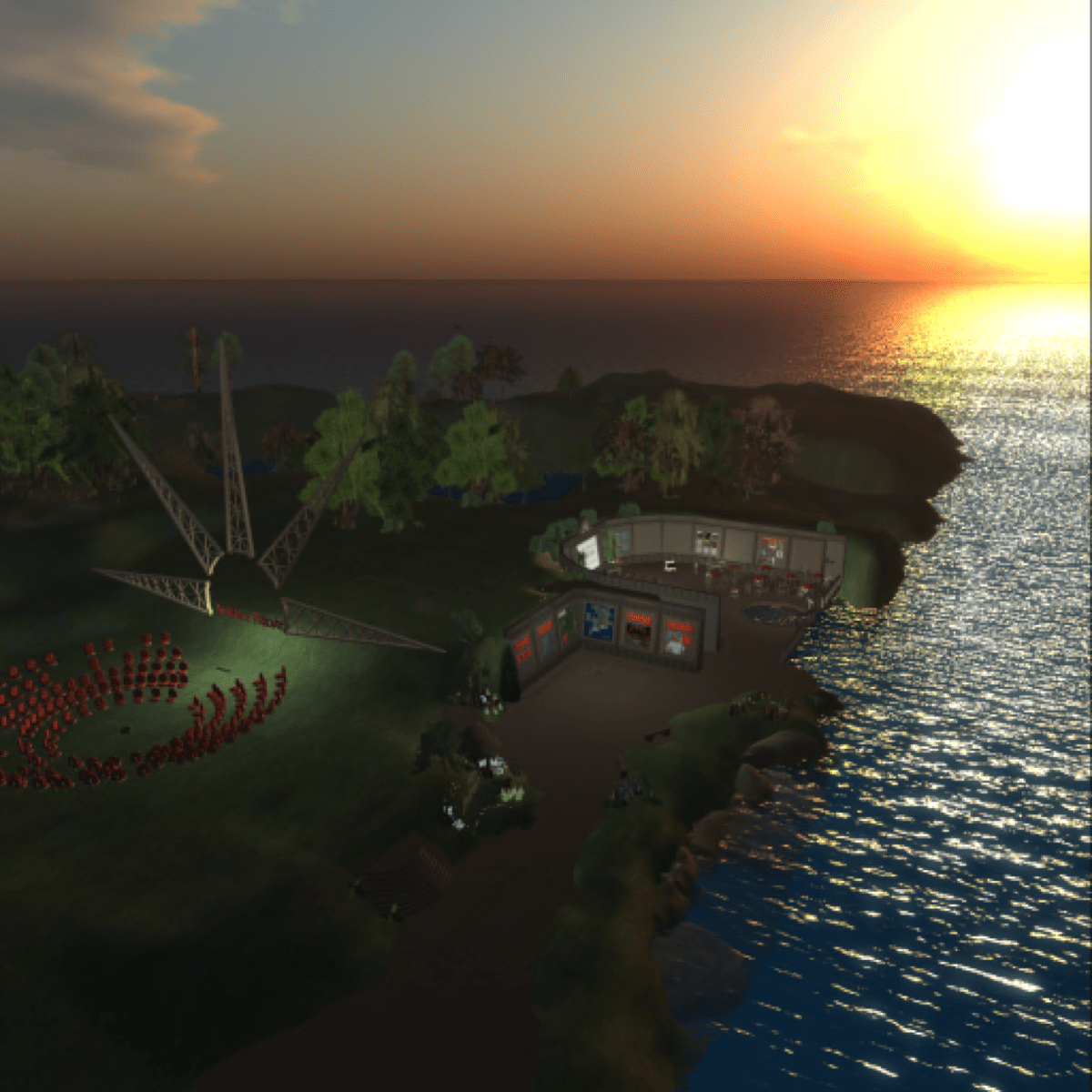
Invest in quality science journalism by making a donation to Science Friday.
Matt Burr is a patent attorney and is a member of the Science Friday Second Life group.
CB Axel is a member of the Science Friday Second Life group.
Violet Azemus is a member of the Science Friday Second Life group.
Lynn Cullens is a former mountain lion preservationist and former administrator of the Science Friday Second Life group.
Celia Pearce is an associate professor of game design at Northeastern University.
Katherine Isbister is a professor of Computational Media at the University of California, Santa Cruz. She is also the author of How Games Move Us: Emotion by Design (MIT Press, 2016).
Ira Flatow is the founder and host of Science Friday. His green thumb has revived many an office plant at death’s door.
IRA FLATOW: Hey there, Ira here. Since the pandemic started, a lot of us have transitioned from living and working in the real world to the virtual world. You know what I mean, seeing our co-workers and friends and family on Zoom rather than in the office or at their house. And it’s been making us at SciFri think about virtual worlds of another kind.
I’m talking about worlds like Second Life. Do you remember Second Life, that online 3D virtual world where you can make your own avatar and you wander around and meet people and build things? If you recall, Science Friday actually had a big presence in Second Life in those early days.
And some of you might remember that we streamed our show there every Friday in the late arts. And fans would come and listen and chat about the show with us. It was like a giant live book club. Tons of fun, some really cool avatar costumes. Well, sadly we had to leave after a couple of years.
But our producer D Peterschmidt recently learned that some of our fans are still there. And things got pretty dicey for them after we left. D also learned from people who have spent over a decade in Second Life how virtual worlds like these can help us cope with our virtual world now. Well, better than me, let me have D tell you all about it.
D PETERSCHMIDT: One of my jobs at Science Friday is to help manage our Twitter account during the live show. And one Friday afternoon last January, we got a message from a Twitter user named Beragon. He said the show’s streaming link was broken and he needed a new one so he could listen on Second Life. And I was, like, wait—Second Life?
NEWSCASTER 1: One of the fastest growing websites on the internet is a 3D world called Second Life.
NEWSCASTER 2: This is supposed to be me, kind of. It’s called an avatar. And it’s part of a world some people call very cool, while others consider it very weird.
D PETERSCHMIDT: Yes, that Second Life, the online virtual world that became kind of a cultural phenomenon in the early 2000s. If you’ve never seen Second Life, imagine a vast ocean dotted with thousands of small islands and large continents. Like Ira said earlier: Signing up is free, anyone can create an avatar, and you can really live a second life there.
You can meet other people. You can build bustling cities and blissful forests. You can make and sell things and earn real world money. Second Life really took off in the early 2000s. And it had a million regular users at its peak. But it became the butt of jokes in pop culture, the kind of thing that Dwight from The Office was into.
JIM HALPERT: You playing that game again?
DWIGHT SCHRUTE: Second Life is not a game. It is a multi-user virtual environment. It doesn’t have points or scores. It doesn’t have winners or losers.
JIM HALPERT: Oh, it has losers.
D PETERSCHMIDT: Mean dig aside, Dwight wasn’t alone in loving Second Life. A little over a decade ago, Science Friday was pretty excited about it too. So excited that we started our very own Second Life community in 2007.
And then we forgot about them. But keep in mind, this was 13 years ago. No one I talked to really remembers how it started. But Ira did remember how he felt about it.
IRA FLATOW: I do remember being very excited when I heard about it.
D PETERSCHMIDT: Ira Flatow, host of Science Friday.
IRA FLATOW: The idea that you could create a whole new world and put down roots and have a spot where people could come and listen to Science Friday early on, that was crazy. I thought that was kind of cool.
D PETERSCHMIDT: We basically wanted to throw an awesome Science Friday party in Second Life. So one day, Ira announces on the radio that we’d be streaming the show into Second Life. Anyone could log in and listen virtually with us. The thing is, we had no idea what we were doing.
We started renting an island. Side note, you can rent or buy land in Second Life and kind of do whatever you want with it. But besides a couple of trees and a pond, there was nothing on it. And no one wants to hangout with you on a barren island.
LYNN CULLENS: Science Friday was my favorite show. And eventually I volunteered to manage and build out the Science Friday island.
D PETERSCHMIDT: Luckily, Lynn Cullens, a retired mountain lion conservationist and Science Friday superfan heard our call out on the radio and volunteered to be our virtual world architect and guide. Do you remember a moment early on when you were playing it and you were like, ‘Wow, this is really working for me?’
LYNN CULLENS: There were so many. The moment when I first created a primitive object in Second Life and realized that I could change this world. I wasn’t just playing in it. I was creating it.
D PETERSCHMIDT: Designing an island isn’t an easy task. But what Lynn created was beautiful. She built an amphitheater right on the water. And from it, every evening, you’d get this stunning view of the digital sunset. You can check out photos of it on sciencefriday.com/secondlife.
The amphitheater tour had big, red, comfy-looking chairs where visiting avatars could come sit in a circle. And in the center, it was just a normal looking office chair where’s Ira’s avatar, Ira Flatley, would preside. Yeah, Ira Flatley, not Flatow.
IRA FLATOW: I had a lot of trouble with the Ira Flatley avatar because I could not get it to look like me. I got as close as I could to it. I’m not great at graphics.
D PETERSCHMIDT: But not that close. This was not public radio host Ira. This was Baywatch Ira—massive biceps, 8-pack abs.
IRA FLATOW: I never had such a good body as that avatar has. So I was happy at least with that.
D PETERSCHMIDT: So Science Friday Second Life was all set to go. We had an amphitheater, we had a beefcake Ira. What more do you really need? People of course. Lynn built it. And after some shout-outs from Ira on the radio, they came. All kinds of creatures. There was Violet Azemus, who showed up as a rabbit.
VIOLET AZEMUS: Like a realistic rabbit. As for why, I don’t know. Bunnies always spoke to me.
D PETERSCHMIDT: CB Axel, a retired paramedic, came as a human.
CB AXEL: She’s younger than I am in real life. She’s thinner than I am in real life.
D PETERSCHMIDT: And of course, Beragon, the person who wrote to us on Twitter. His avatar is tall and comic book muscular with long silky hair.
MATT BURR: My avatar is really handsome. I like my avatar to be hot.
D PETERSCHMIDT: In real life, he’s Matt Burr, a patent attorney with a degree in molecular biology. Usually there’d be around 70 people who’d show up every week. But at its peak, the group had a huge amount of members, over 2,800 people. There were so many people showing up that we had to set up an overflow space so the island wouldn’t crash.
IRA FLATOW: Let me see if I can get one more audio question in from Second Life.
D PETERSCHMIDT: One of the group’s favorite things about the shows was being able to send their questions to Ira through the chat.
SPEAKER 1: A few billion years from now, the sun’s gonna become much brighter, swell into a red giant and scorch the surface of the Earth. What we’re looking at on Mercury right now, will that tell us anything about what it will be like on the Earth this time a few billion years from now?
IRA FLATOW: Wow, that’s a really good question.
CB AXEL: Whenever Ira would say, “here’s a question from so-and-so in Second Life,” everyone would get really excited. “Yay, we’re mentioned and congratulations you got your name on!”
LYNN CULLENS: It was really fun and exciting for all of us to hear. It made us feel part of the radio show.
D PETERSCHMIDT: So during the live broadcast, Lynn moderated the chat and sent the best questions to the studio. She remembers this one time while she was moderating and there was this massive thunderstorm happening in Sacramento where she lived.
LYNN CULLENS: And at the same time, I was watching 100-year-old elm tree whip wildly about and crash through the roof at the church across the street. And I just kept typing because what was happening in my home was very different than what was happening in the studio in New York and very different from what was happening under the clear blue skies in Second Life. And that was part of the magic was being three places at once.
D PETERSCHMIDT: But despite what a frantic job it must have been—
LYNN CULLENS: It was an experience that I looked forward to every single week. I remember a couple of times going out with Ira and walking around the island and chatting about the show. And it’s one of the highlights of that relationship for me was to be able to spend that time with Ira.
D PETERSCHMIDT: Why did we leave Second Life?
IRA FLATOW: We left Second Life on a purely monetary basis. It was too expensive, to put it simply.
D PETERSCHMIDT: It was 2009. We’d been in Second Life for roughly two years. And we’d reached a point where renting an island was just outside our nonprofit budget—roughly $800 a month in rent. And as the executive producer of the show, Ira had to make a difficult call.
IRA FLATOW: The hardest thing was the decision to say goodbye. And that really was the hardest part of Second Life.
D PETERSCHMIDT: Because we stopped paying for the island, it disappeared. Ira and our other admins stopped logging in. And Lynn, our Second Life maestro, left Second Life entirely. And that appeared to be the final nail in the coffin.
Lynn was gone. We were gone. The island was gone. The space we helped grow over two years was swiftly dismantled. Violet, one of the members of our group, says, losing communities in Second Life is pretty normal. And at some point, you just get used to it.
VIOLET AZEMUS: Personally I wish more spaces would last longer. A lot of my favorite spaces are gone now. And I miss them. I wish I could access those spaces again. But things are more transient.
An interesting thing I’ve noticed is a prevalence of Buddhist groups in Second Life. Sort of central to Buddhism is the idea of impermanence and letting go of attachment to things. And I’ve always wondered how literally that can be applied to a constantly changing virtual world where things are just gone all the time.
D PETERSCHMIDT: These vanishing virtual lands, it’s a trend across all kinds of tech platforms. And when online community spaces disappear, users are often abandoned and left to fend for themselves. And that’s what we thought happened to the SciFri island; just swept away with time.
But it turns out our Second Life listeners decided that even though we left, they weren’t done with this. So they decided to pick up the pieces and ran into some snags along the way.
MATT BURR: Yeah, here we can get into the whole soap opera, which I’ve been waiting to tell you actually.
D PETERSCHMIDT: We have that story after the break.
When we left Second Life back in 2009, that’s where we thought the story ended. It was something our longtime staff members would talk about occasionally at happy hours, that for a couple of years we did these cool, kind of kooky broadcasts from a virtual world. But then we left. But for our Second Life group, that was very much not the end of the story.
MATT BURR: Yeah, here we can get into the whole soap opera, which I’ve been waiting to tell you actually.
D PETERSCHMIDT: At first, things weren’t so bad. They went back to a public space where the SciFri stream was originally hosted. But that soon closed down too. After that, the group hopped from private island to private island, hosted by different members in their group who already had their own land.
But their numbers dwindled to about 20 people because being on private islands, there weekly meet-ups were now closed off to the public. Plus Ira wasn’t doing shout-outs on the radio anymore. One of the members, CB Axel, sent me a screenshot from this time. It’s a group of about a dozen avatars, some sitting around a glass conference table, overlooking an ocean at sunset.
Propped on top of a wooden box is a projector screen that reads “Keep Sci Friday in Second Life.” The fact that the group was starting to get so small, that bothered Matt and the others. They originally joined the SciFri Second Life group because of all the people and the exciting conversations that would spring up in the chat. So they decided to do something about it.
MATT BURR: We sort of wandered the desert for a few years, basically gathering in public places.
D PETERSCHMIDT: They decided to leave their safe private islands and head back out into public land. Matt hoped that being out in public spaces where anyone could listen in might help them recruit more people. And soon they found a public space that hosted an NPR stream that carried Science Friday.
In many ways, it seemed like the solution to their problems. But there were some downsides. Like, when anyone can join your group, “anyone” can join your group.
MATT BURR: We had no admin rights to control access to the land. So our gatherings in public spaces attracted an unsavory element of the public. It was basically two guys, just griefer and trolls and climate change deniers and wackadoos. And they would come in and provoke arguments with us and stuff like that. And they would end up dominating the conversation.
D PETERSCHMIDT: So the griefers, which is Second Life lingo for trolls, didn’t just stick to climate change denial but tackled a range of anti-science issues like anti-evolution. They would show up every Friday at their meeting place like clockwork and harass the group members.
MATT BURR: They wouldn’t even necessarily wait for the topic. They would just start griefing us right off the bat, as soon as they got there. That was their whole point.
D PETERSCHMIDT: Matt and the others, they didn’t ignore them. But they actually went toe to toe with them.
LYNN CULLENS: I generally do push back on things like that when I see them. But with someone like that who’s doing it continuously and probably not doing it in good faith, it hits a point where you’re just talking to a wall.
MATT BURR: Sometimes they would devolve into personal insults where we’re calling each other stupid and “you don’t know what you’re talking about” and “you’re just a troll.” And they would not take a hint. I mean, they would show up week after week after week after week with the same routine. And they didn’t listen to our complaints. So it became quickly evident that it was not being done in good faith, that they were just there to disrupt us.
D PETERSCHMIDT: And there wasn’t much they could do. No one in the group had admin privileges. So they couldn’t kick anybody out. And the group put up with all of this for a long time.
MATT BURR: So we actually tolerated it for years.
D PETERSCHMIDT: How many years do you think, roughly?
MATT BURR: Five years. We put up with it for a long time because we wanted to– we had some pride in being able to listen to other points of view and to address them and so forth.
D PETERSCHMIDT: But eventually, enough was enough.
MATT BURR: We had to get control of the situation.
D PETERSCHMIDT: They really needed those admin privileges back. So roughly two years ago—
MATT BURR: So I did that. I created a new Science Friday group: Science Friday, the next generation.
D PETERSCHMIDT: That’s great.
They needed private land again. And luckily one of their members, CB, actually had private land and offered up part of her space where they could all meet. Now, this space is no sprawling outdoor amphitheater. It’s kind of the opposite.
It’s basically a game room. Homey, with lots of couches, a couple of card tables at the back. But they finally had safe haven once again. So after all the trouble they went through over the years just to listen to a show together, I was wondering was it all worth it? Matt says, basically it was because of the community.
MATT BURR: It’s like walking into the Cheers bar, I guess, whenever Norm would come into the bar and everyone would go, “Norm!” Right? It’s like that. It’s like everyone knows your name kind of thing.
D PETERSCHMIDT: When Matt went into Second Life over a decade ago, he wasn’t expecting it would end up meaning so much to him.
MATT BURR: It kind of snuck up on me that it would become so important. I have a great family. And I have a lot of great friends. But this is just a particular idiosyncratic interest I have that I don’t really have a real life community to share it with. But here, I do. And so I just don’t want to lose it.
D PETERSCHMIDT: Although Matt has spent less time in Second Life than he thought he would during quarantine, it’s still a valuable place for him.
If you didn’t have the history that you do in Second Life, do you think your emotional well-being would be worse off right now?
MATT BURR: Yes, I definitely do. Because I have this great resource that’s going to help me cope with it. It is a comfort to me to know that Second Life is right there, just a click away, if I start feeling lonely or something.
D PETERSCHMIDT: And that’s something I was thinking a lot about as I was working on the story. Now, during the pandemic, a lot of us are stuck at home. Our previous social lives are in pieces. And Zoom calls aren’t really ideal replacements for face to face interactions. So could Second Life and other virtual worlds give us something that endless video meetings can’t?
KATHERINE ISBISTER: I remember having this moment where I felt like I might be living in the matrix where it was, like, are these people anything more than talking heads?
D PETERSCHMIDT: Katherine Isbister is a human computer interaction and games researcher at the University of California, Santa Cruz. And like a lot of us, she spent a lot of time in the past few months on video chat.
KATHERINE ISBISTER: And then I was I was having a co-working meeting with a friend. And I could see her in the background making her tea. And it was just so comforting to see her doing that in her own space.
And I think what is really interesting about shared worlds is you can go through the ritual of making tea together. You can sit quietly and just say nothing in an online world and still feel a sense of co-presence. You can get in a virtual boat and just be rowing for a while and say nothing.
D PETERSCHMIDT: Seeing the avatar’s whole body, even though it’s virtual, Matt says that for some reason it’s actually really satisfying.
MATT BURR: I think that virtual world avatars have an unappreciated psychological power. It’s especially true in a world like Second Life where you create your own avatar from scratch basically. So that avatar is an actual creative expression of yourself. You’re emotionally invested in your avatar. So being in the presence of avatars triggers perfectly real emotional responses to things.
D PETERSCHMIDT: For Celia Pearce, an associate professor of game design at Northeastern University, this checks out with the research she’s done on virtual worlds. In 2015, she released the results of a demographic survey with over 800 participants that she conducted on these worlds. Who uses them, how they use them, and why?
And one of the most surprising findings was that some people reported that using virtual worlds helped mitigate depression and even suicide, especially if they were disabled or trans. Support groups in the virtual world helped, but also just regular old playing; whether it was role play as different creatures, like vampires; holding events; dancing; or even people creating their own games. And unlike other games, most people using virtual worlds aren’t teens. They’re usually Gen-Xers or baby boomers.
In the quarantine era, what does Second Life have to offer to us right now?
CELIA PEARCE: I think it offers a connection through play. In the US for instance, I think we have a little bit of Protestant work ethic baggage that really kind of marginalizes play. And I think that adults just need other forms of play besides sports that are socially acceptable. What I’m seeing right now that’s super-exciting is we’re starting to see more and more of this.
D PETERSCHMIDT: So this normalization of adult play in virtual worlds, it’s helping marginalized communities with their mental health. It’s allowing others to freely explore their identities. And it’s helping a lot of people with loneliness. In Celia’s survey, many disabled people self-reported that they use virtual worlds to mitigate loneliness. These worlds, and the play that happens inside them, give people social connection; connection that a lot of us are missing right now.
CELIA PEARCE: I think we all need to play more. And how we choose to do that is really up to our personal tastes.
D PETERSCHMIDT: That conversation between Dwight and Jim in The Office clip I played at the beginning, that’s kind of how society has looked at virtual worlds like these—as a sad waste of time. But it seems like we’ve made some progress since then.
Animal Crossing, a game that shares a lot of the social and creation DNA of Second Life, recently became one of the best selling games of all time, proving just as popular with adults as it is with children. Just ask the members of the SciFri staff who are part of her Animal Crossing Slack channel. And in the midst of quarantine, it looks like people are responding to this return to play.
Linden Lab has seen about a 20% increase in users that are logged into Second Life at a given time, roughly the same rise that Twitter saw with its users since the pandemic started. Now, there’s about 50,000 people playing Second Life at any one time. It’s clear that Second Life means a lot to people, even to someone like Lynn, who doesn’t play it anymore.
LYNN CULLENS: People that play video games, especially multiplayer online games, will recognize pull of these virtual worlds. And Second Life is special in that regard.
D PETERSCHMIDT: And after a while, Lynn realized that that pull had gotten too strong for her.
LYNN CULLENS: Over time, I began to feel the loss of experiencing my other senses in the world outside.
D PETERSCHMIDT: Lynn loved Second Life. She was able to completely financially support herself in-world. But she ended up spending about 14 hours a day there for a couple of years, including weekends and holidays. And it turns out Second Life can’t completely replace your first life.
LYNN CULLENS: I missed things like the scent of flowers on the breeze, the buzz of insects, the taste of a fizzy drink and not just one that looked good on a screen, the subtlety of a unique sunset instead of the same old sunset on the Science Friday island.
D PETERSCHMIDT: Lynn doesn’t look back on her time there as a waste. I mean, she was experiencing real life in Second Life. She had real jobs that paid her real money. She formed real memories and had real relationships. Here’s Celia again.
CELIA PEARCE: These are real people. They have real feelings and real experiences. And they care about each other. And one of the things that I try to do in my work is I try to get away from the idea that somehow digital makes things that radically different.
It’s all part of how people make meaning in their life. And sometimes they make meaning in their life by exploring alternate universes. So I think the digital sphere is just one more way that we do that. It’s not really that different from going to a movie or reading a book or going to a Halloween party. Right? It’s just a different way of expressing ourselves and imagining ourselves in a different reality.
D PETERSCHMIDT: CB Axel feels similarly.
CB AXEL: It gives people a chance to meet others who have their same interests and some of the same difficulties they have in real life. And they can just shake off those difficulties and become the person that they want to be.
D PETERSCHMIDT: And as far as the Science Friday next generation group goes, they’ve still been meeting up every Friday, continuing a tradition that for many of them goes back 13 years.
DIANA MONTANO: Whoa. It is very weird just to see people flying around in here.
D PETERSCHMIDT: After catching up with the members of the original Science Friday Second Life group, after learning everything they went through, I felt like it was only fitting that we had a reunion. And even though we’d abandoned them a decade ago, they were willing to host us. So Ira and myself, and a group of us from Science Friday, made Second Life accounts; learned how to put on different outfits; and slowly learned how to move around.
ALEXA LIM: What? Are we all in different rooms? I’m watching the Weather Channel in a dungeon or something.
[LAUGHTER]
D PETERSCHMIDT: Playing Second Life today is kind of like going back into a time machine. The graphics haven’t really changed since the early 2000s. But trying to learn how to use it, even thought it was really tricky and confusing, it was actually kind of fun.
KATHLEEN DAVIS: People are chatting me. People are chatting me being like, “hey, girl what’s up?” [LAUGHTER] In the tutorial.
LAUREN YOUNG: Wow, you’re so popular.
DIANA MONTANO: Nobody’s chatting me.
LAUREN YOUNG: Me neither.
KATHLEEN DAVIS: It’s ’cause I have a big hat on and I look like a very distinguished lady.
D PETERSCHMIDT: I spent over two hours making my own avatar. But I didn’t really like it. You know, just slicked back wet hair and torn skinny jeans. And it just looked like they were about to head to a punk concert or something. But I really dug my co-workers avatars—a mage, a werewolf, and of course Baywatch Ira.
LAUREN YOUNG: Oh my god, we’re doing it. 30 minutes later, guys, and we finally are meeting up with each other.
DIANA MONTANO: I think I found y’all.
LAUREN YOUNG: Oh, I see you. Yay!
D PETERSCHMIDT: Eventually we all teleported to CB’s space. It was a Friday afternoon. And for the first time in a decade, we were all going to listen to the show together again. And things had changed. There was no more amphitheater, no more giant rising sun, just a homemade game room.
IRA FLATOW: Yeah, it seems to be people are filtering in, as we used to say. And we’re not even offering hors d’oeuvres. That’s the miracle of it.
D PETERSCHMIDT: So we got there early. And as we were finding our seats, we watched as members of the original group teleport in one by one. There was Beragon, a.k.a. Matt Burr looking strong and stoic. Violet was hopping around in her realistic rabbit avatar. CB was wearing a Science Friday t-shirt that she made.
IRA FLATOW: I see Bjorlyn Loon.
D PETERSCHMIDT: Yep. That’s Lynn Cullens, Ira.
IRA FLATOW: Yeah, wow. That brings back memories.
D PETERSCHMIDT: And Lynn, who hasn’t really set foot in Second Life since 2010, returned as well. As each person teleported in, the group chat sprung to life. It was just like Matt said, like walking into the bar from Cheers. And for Ira, who since this pandemic started has missed doing a live show and having live people call in, he was ecstatic to have something akin to a live audience.
Over the course of the show, hundreds of messages were sent through the group chat discussing the segments. And by the time the second hour had started, there must have been about 20 people there. And the game room felt full and alive.
IRA FLATOW: Oh, no! I’m out of the picture, I’m out of the picture!
[LAUGHTER]
DIANA MONTANO: Only in Second Life.
D PETERSCHMIDT: This story was reported, written, and hosted by me, D Peterschmidt. and I also composed original music, did the sound design, and mastered the episode.
ELAH FEDER: I’m Elah Feder.
LAUREN YOUNG: And I’m Lauren Young. And we edited this story.
DANYA ABDELHAMEID: Fact-checking was done by me, Danya AbdelHameid.
GICA TAM: I’m Gica Tam and I illustrated original art for this episode.
NADJA OERTELT: Science Friday’s chief content officer is me, Nadja Oertelt.
D PETERSCHMIDT: And special thanks to Kyle Marian Viterbo, Johanna Mayer, Alexa Lim, Ira Flatow, and the rest of the Science Friday staff and Liam Tully. You can read more about the fascinating social dynamics of virtual worlds in Celia Pearce’s excellent book, Communities of Play: Emergent Cultures in Multiplayer Games and Virtual Worlds, which helped me so much with the research for this episode.
LAUREN YOUNG: Fly! Yes, I’m flying. Whoa, OK, wait. OK, a little too—I’m dancing on the ceiling. OK, wait. How do I get down? “C.”
Yes, I rule. Oh, I fell. I totally fell and ate it. I hope you use all this audio, D, of my very, very detailed explanation of this tutorial. OK, step 4.
Copyright © 2020 Science Friday Initiative. All rights reserved. Science Friday transcripts are produced on a tight deadline by 3Play Media. Fidelity to the original aired/published audio or video file might vary, and text might be updated or amended in the future. For the authoritative record of Science Friday’s programming, please visit the original aired/published recording. For terms of use and more information, visit our policies pages at http://www.sciencefriday.com/about/policies/
Dee Peterschmidt is a producer, host of the podcast Universe of Art, and composes music for Science Friday’s podcasts. Their D&D character is a clumsy bard named Chip Chap Chopman.